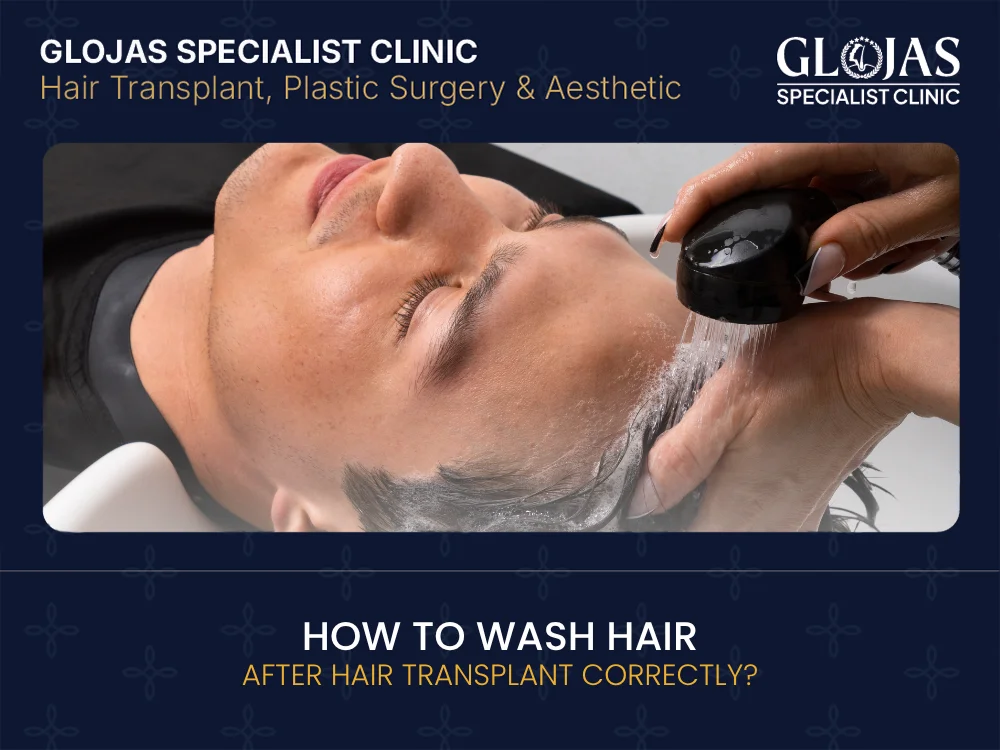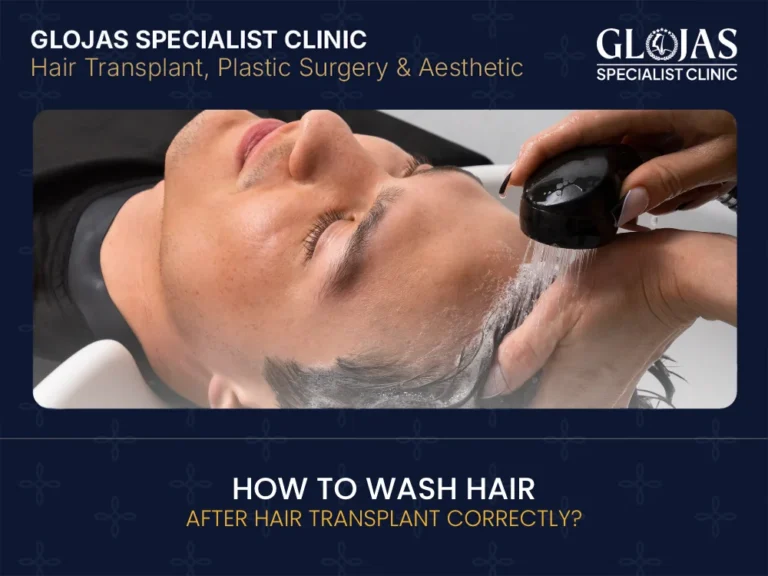When you undergo a hair transplant, one of the most crucial parts of your recovery is how you wash hair. If done incorrectly, you risk damaging grafts or delaying healing; done right, you support optimal growth, cleanliness, and scalp health. In this guide, we’ll walk you through the timeline, techniques, dos and don’ts, and expert insights (from ABHRS/ISHRS-level advice) so you can wash hair safely and confidently after your procedure.
When to First Wash Hair After Transplant
You should avoid wash hair immediately. Most surgeons recommend waiting at least 48 hours (2 days) after surgery before attempting any wash.
Some clinics delay until day 3 to day 5 to allow grafts to settle.
The precise timing depends on the technique (FUE, FUT) and your surgeon’s protocol, so always follow your surgeon’s instructions as the primary guide.
After that initial period, a gentle washing routine begins — usually daily or twice daily for the first 1–2 weeks — to remove dried blood, crusts, debris, and reduce infection risk.
Why Gentle Washing Is Essential
Wash hair post-transplant isn’t just about hygiene. It:
- Prevents infection by clearing blood crusts and bacteria
- Helps the scabs soften and gradually fall off
- Stimulates scalp circulation (without trauma)
- Maintains a clean environment for graft survival
However, overly aggressive scrubbing, high-pressure water, or picking scabs can dislodge grafts, cause bleeding, impede healing, or even lead to graft failure.
Thus, the method matters as much as the frequency.

Step-by-Step: How to Wash Hair After Hair Transplant
Below is a typical approach (general guidance) to wash hair after transplant:
- Soften crusts / scabs (optional pre-treatment, if your clinic provides lotion).
Some surgeons or clinics offer a softening lotion or foam to apply ~30–60 minutes before the wash to loosen crusts gently. - Use lukewarm, low-pressure water.
Do not place your head directly under a strong shower jet. Instead, use a cup, pitcher, or reduce pressure. - Use surgeon-recommended or mild shampoo.
Dilute the shampoo with water (so it’s milder) and use your fingertips (pads, not nails) to gently tap or massage the scalp. Avoid rubbing or scratching. - Let shampoo sit briefly (if advised).
In some protocols, letting the shampoo foam sit for a minute or two can help loosen debris. - Rinse gently with lukewarm water, low force.
Use a cup or let water flow gently over the scalp to wash away suds. - Dry by patting or air-dry.
Avoid rubbing with towels. Use a clean, soft towel or paper towels to pat gently. Avoid hairdryers for the first week or more; if needed, use cool, distant airflow. - Do not pick or scratch scabs.
Let scabs naturally shed. Picking can uproot hair follicles. - Resume gentle combing (if absolutely needed).
After ~1 week, you may very gently comb using wide-tooth or soft comb, avoiding tension on recipient area.
Over time, as grafts anchor and scabs disappear (by ~10–14 days), you gradually return to your normal washing routine, reintroducing your regular shampoo, conditioner, and styling products as permitted by your surgeon.
Timeline of Hair Washing After Transplant
Period | What to Do | Key Cautions |
Day 0–2 | Avoid washing hair | Let grafts stabilize; use saline spray if instructed |
Day 3–5 | Begin gentle washing | Use diluted shampoo, low pressure, soft taps |
Days 6–14 | Continue daily washing | Remove crusts gently, maintain hygiene |
After 14 days | Gradually resume regular washing | Reintroduce usual shampoo, mild massage |
1 month onward | Normal hair care routine | Monitor scalp, avoid harsh chemicals |
This timeline aligns with many clinical guidelines.
Common Mistakes to Avoid
Even the most successful hair transplant procedure can be compromised by small post-care mistakes. The early recovery phase is critical for graft survival, and your scalp needs gentle handling to heal properly. Here are the most common mistakes patients make — and why avoiding them is essential for long-term results:
Washing too early (before grafts settle)
Washing your hair too soon after surgery can dislodge newly implanted grafts before they’ve had time to anchor securely in the scalp. Most surgeons recommend waiting at least 48–72 hours before the first gentle wash. Always follow your doctor’s timeline and instructions carefully.
Using hot water or high-pressure jets
Hot water can irritate sensitive skin and increase swelling, while strong water pressure can dislodge delicate grafts. Instead, use cool or lukewarm water and let it flow gently over your scalp. Avoid using a showerhead directly on your head during the first week; instead, pour water using a cup or your hands.
Scrubbing or rubbing vigorously
Even if your scalp feels itchy or flaky, don’t scratch or rub it. The newly transplanted follicles are fragile, and friction can easily damage them. Lightly pat your scalp dry with a soft towel or allow it to air-dry to minimize irritation.
Picking scabs with nails
Scabs are part of the natural healing process, protecting grafts while they settle. Picking at them can lead to infections, scarring, or even loss of transplanted hairs. Let scabs fall off naturally, usually within 10–14 days after surgery.
Using aggressive shampoos or styling products too soon
Chemical-laden or harsh shampoos can irritate healing skin and delay recovery. Use only mild, doctor-approved cleansers during the first few weeks. Likewise, avoid gels, sprays, or styling creams until your surgeon confirms it’s safe — usually after the first month.
Using a hairdryer on high heat
High heat can damage both your scalp and fragile new follicles. If you need to dry your hair, set your dryer to the coolest, lowest setting, or let it air dry. Protecting your scalp from heat helps grafts stay healthy and encourages natural hair regrowth.
Exposing the scalp to strong sun or sweat during early days
Direct sunlight, heat, or heavy sweating can irritate your scalp and increase the risk of infection. Avoid outdoor activities, gyms, saunas, and direct sun exposure for at least 2–3 weeks. If you must go outside, wear a loose-fitting hat for protection.
What Shampoo or Products to Use
- Use the shampoo provided by your surgeon or clinic (often gentle, sulfate-free, pH-balanced)
- If none is given, choose a mild, fragrance-free, low-sulfate shampoo
- Avoid parabens, harsh surfactants, alcohols, or irritating additives initially
- Avoid any hair sprays, gels, or chemicals until your surgeon approves
- After ~2 weeks, you may slowly reintroduce gentle, non-irritating hair care products
What to Expect & How to Monitor
- You may notice “shock loss” where some transplanted hairs shed — this is normal and temporary.
- Scabs usually fall off between days 7–14
- Mild itching is common — avoid scratching
- If you see signs of infection (swelling, persistent redness, pain, pus) — contact your surgeon
Why GLOJAS Specialist Clinic Is Your Trusted Choice
At GLOJAS Specialist Clinic, our team brings over 25 years of expertise in hair restoration. We are ABHRS & ISHRS certified, meaning we adhere to global best practices and scientific protocols in hair transplant and aftercare. When you trust us, you get not just the surgery, but a full care plan — including guidance on how to wash hair after hair transplant correctly — that maximizes graft survival, supports healing, and ensures natural, lasting results.
10 FAQs — How To Wash Hair After Hair Transplant
- When exactly can I wash hair after transplant?
Typically around 48 hours (day 2) or sometimes day 3–5, depending on your surgeon’s protocol. - Should I wash hair twice a day initially?
Many clinics advise washing once or twice daily in the first 1–2 weeks to remove crusts, but always follow your doctor’s specific instructions. - Can I use my regular shampoo immediately?
No — use the mild shampoo provided or a gentle formula until cleared by your surgeon. - How should water be applied to my scalp?
Use lukewarm water with low pressure — pour from a cup or use gentle spray, avoid direct jets. - Is it okay to use a hairdryer?
Not early on. Use air drying or pat gently. If using a dryer later, use the lowest, coolest setting. - Can I scrub or rub my scalp?
No — always use light tapping or fingertip motions. Avoid aggressive rubbing or scratching. - What about scabs — should I pick them?
Never pick scabs. They should fall off naturally as washing and healing proceed. - When can I resume normal hair care (conditioning, styling)?
Usually after 2 weeks or as advised by your surgeon. Gradually reintroduce gentle products. - What if I see hair shedding after washing?
That’s likely “shock loss,” a normal temporary phenomenon. It doesn’t mean grafts failed. - How to prevent infection while washing?
Keep hygiene high, wash daily gently, avoid contamination, use sterile or clean implements, and contact your surgeon if signs of infection appear.
Final Thoughts & Call to Action
Mastering how to wash hair after hair transplant is not optional — it’s essential. Gentle washing, timing, correct products, and technique all play a major role in graft survival and optimal results. While this guide gives you evidence-based and practical direction, your surgeon’s personalized instructions must always take precedence.
If you are considering a hair transplant or need expert post-op care, turn to GLOJAS Specialist Clinic. With over 25 years of experience, and certifications from ABHRS and ISHRS, we provide you with world-class care — from surgery to aftercare, including hair-washing protocols designed for your success.
👉 Contact GLOJAS Specialist Clinic today to schedule your consultation or learn more about our post-transplant guidance.
